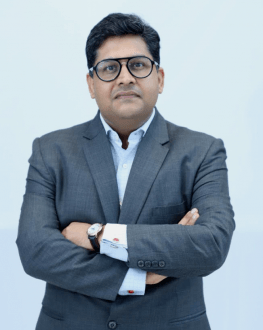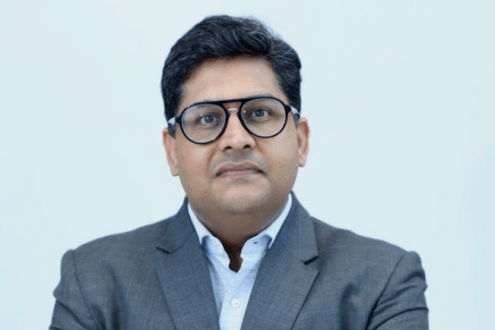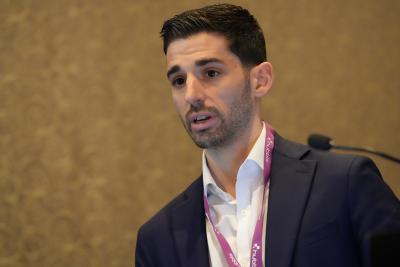LC Capital India’s (Lighthouse Canton, India) CEO for India on Conveying the Brand, Expanding the Team and Building Momentum

Sumegh Bhatia of Lighthouse Canton
Apr 1, 2022
Sumegh Bhatia is Chief Executive Officer & Managing Director for the India arm of Lighthouse Canton, which is on a rapid expansion trail globally, with its offices in Singapore, Dubai and India. Hubbis ‘met’ with him recently to learn more of the thrust in India and where the firm sees its true competitive edge. India’s wealth management market is clearly on a roll. Buoyed by the remarkable performance of the equity market in the aftermath of the 2020 pandemic-induced sell-off, encouraging economic data, and by the growth of private wealth and the diversification of their investments. Lighthouse Canton opened in India only in 2020, with 2021 as the first full year of operation, but the progress is impressive so far, prompting them to open their second office in late 2021. Sumegh believes that the firm is well-positioned as both a local Indian EAM and also as part of an international operation to expand apace in India’s dynamic wealth market.
Sumegh first explains that the firm has two licenses, both granted by the Securities and Exchange Board of India (SEBI). One is a pure distribution license and the second is the Alternative Investment Fund (AIF) license, allowing them to invest in early stage private companies. He reports they have launched a VC fund in India, and they plan to offer a venture debt fund in mid-2022. They are also applying for a third license for portfolio management.
Today, the team operates out of Delhi for northern India, they opened the Mumbai office in late 2021, and centre of excellence and technology centre in Bengaluru, from where they handle the needs of Singapore and Dubai as well. The team totals 20 located in Delhi and Mumbai and includes six bankers currently.
A blue-chip background
Sumegh’s background is as a Business leader with two decades of experience in private banking. Before joining the firm, he worked with names including Avendus, Citi Private Bank and Reliance Private Client, where he built the wealth business from the ground up, and his last role was as Executive Director at Avendus Wealth Management, the private banking arm of Avendus Group, a prominent and diversified financial services group in India and in which since 2015 US-based private equity giant KKR and another private equity firm are core shareholders.
He explains that their target market is the U/HNW community in Indian with financial wealth of USD30 million or more and including single family offices.
Knowing their market
“We currently work closely with a few of the largest single-family offices in India,” he reports. “We are building the platform with differentiated strategies to appeal to a variety of clients, and of course with a very much international approach to their portfolios and their wealth structuring. Many Indian families are moving wealth offshore and building structures offshore, and we are uniquely well-positioned to help them.”
Expanding on this, Sumegh says that while they are a new firm, they already manage more than USD500 million of assets in India, and that is growing fast. “We have highly differentiated institutional-level offering,” he states. “Our services are highly personalised, yet holistic and supported by a comprehensive network of partners, and as we are so focused, we can compete directly with the big players who have a broad mandate amongst many different types of customers.”
Rapid expansion ahead
Today, he reports, the firm works with around 80 families in India, meaning that he and the six RMs are not overly stretched and can offer a very hands-on service. “We will expand to perhaps 250 families in the coming few years, but we will be expanding the bankers, boosting our capabilities and efficiencies, and we believe we will still offer the same type of bespoke service.”
And that begs the question as to how Lighthouse Canton will bring in the types of bankers that they need to maintain that expansion and momentum.
The secret sauce
“A number of the more senior bankers out there want more involvement in the platforms they work with,” he reports. “I have worked for a number of those global and major names, and the potential to have a voice is limited, there are so many levels of decision-making. Whereas some of the very senior bankers who have been working with us, or who are looking to work with us, see us as their platform for their own entrepreneurial journey. They think, and this is what we also firmly believe, that they will be better able to focus on and deliver for their clients.”
He adds that aside from offering an interesting and diverse suite of products and differentiated strategies on the platform, they have also been building their own technology in-house. “Some of the largest of the wealth management firms in India have still not been able to devise solutions themselves. It is not in their DNA, so they outsource, but we believe in-house creativity aligns us directly with our clients,” he comments. “That is a key differentiation.”
Scale and reach
He also says that being part of a rapidly growing group that is headquartered in both Asia and the Middle East offers both additional scale and the capability to offer advice and services from an international perspective. “All our clients are global investors and we cater to those needs and expectations,” he reports.
That leads him to comment on the group itself. Lighthouse Canton across all offices has assets under management and advisory of roughly USD3 billion (as of 31 December 2021) and has been enjoying robust demand for its institutional-style funds and broad-based MFO offerings in Singapore and now also in Dubai.
Indeed, the Singapore-headquartered firm does strive to position itself as offering an institutional-level infrastructure and approach across all its operations and business lines. Hubbis heard in 2021 from Group Chief Executive Officer, Shilpi Chowdhary, that enhanced efficiencies and a major acceleration of digitisation had resulted in greater productivity, helping the firm achieve its rapid growth.
Digital days and ways
Rapid digitisation is central to the mission of the firm, Chowdhary told Hubbis at the time of that interview. He also explained that the next phase of growth would see the firm seeking out more high-quality talent across all its teams, at the same time as expanding its proposition. He pointed to the 2021 hiring of a team of experts in Singapore to transform their private/alternative assets offerings and boost the firm’s asset management activities in the VC/private equity space.
The fee-based client alignment
Back then, Chowdhary had also highlighted the firm’s cast-iron belief in the fee-based approach to the investment advisory and portfolio business. He explained how they combine that with a remuneration protocol that is centred on boosting AUM and avoiding ‘product-pushing’, meaning that the aims of the firm and the clients are neatly harmonised. Focusing specifically on India, Sumegh says that culture and DNA are just as vital to his operation.
As to strategies the Indian firm offers, Sumegh says that classical allocations to the financial markets are not of interest, even though those would have achieved good results since 2020 as the Indian equity market soared. “Our thought process is around absolute return,” he reports. “We look at the portfolios and target specific returns and strategies for the market cycles, and across all segments, not only those areas that have been performing well. So, we are multi-asset, multisector, equity, debt and private or alternative assets.”
Going private
He expands on this comment, remarking that the firm is concentrating heavily on private market assets, building capabilities in-house rather than farming out decisions to external managers. “We believe in our capabilities,” he says. “We have in-house experts, we have the CIO team in place, and we have filed for the AIF license, and to execute our capabilities we do not want to be dependent on some third-party manager. We can work with such external funds, but we will make our own choices. Private markets are gaining in popularity in India, and our expertise combined with our technology will put us in a great position here.”
Outside the core of investment curation, Sumegh also remarks that wealthy Indian clients are also looking for business ideas, especially the Nextgens.
Looking to the future
“The wealthy have their business empires of different sizes, but the Nextgens are scouting for ideas as to how they will build their businesses, and how they can invest in the successful companies of the future here and overseas. And again, this comes back to the private markets, VC and all those ideas and opportunities. The more we can do in putting these various elements together, the stronger we will be.”
And he says this should not be restricted to India. “We need to offer global perspectives and opportunities from around the world, and to that end, the Indian business works closely with the Singapore and Dubai teams to curate an interesting flow of advice, insights and opportunities.”
Defining your identity
Sumegh observes that the expansion of wealth in India and the rapid increase in clients of all types and across the wealth spectrum mean that banks and EAMs must define themselves more precisely in the future. “Not everyone will want to do everything or be capable of spanning all these segments,” he says. “As I see it, there will be a greater focus on specialisations and a trend to carve out different brands or business centres for different segments, so there is a clear distinction.”
He also observes that there are more and more DIY clients increasingly leveraging technologies to help them manage their own investments remotely and seamlessly. He indicated that this also means that the advice on offer needs to become more elevated, to draw those customers to higher value-added products, rather than the basic products now executed on the DIY platform. “We will see more customers going DIY as capabilities and choices increase,” he states. “Even the hedge funds will transition to execute on these DIY platforms.”
And the third key trend he sees is the larger firms wanting to build manufacturing capability because they don't want to be dependent on third party manufacturers. “More product manufacturing skills set will help the companies align themselves more with their target clients, offering them chosen segments the types of products and solutions they know will fit them well. And that is also where we want to be very focused as well.”
Key Priorities
His first mission is to build the brand awareness and reach. “We are right now focusing only on some markets, particularly the north of India and we naturally want to be more visible and in other larger markets within India,” he reports. “And that means hiring more bankers, but very selectively. We envisage a 25-30 strong team of RMs over the coming four years or so.”
His third priority is to focus on building their own asset management capabilities, including across private markets and public markets. And the fourth mission is to expand our technology through in-house development, and to that end we already have our own tech platform in Bengaluru that looks after us, Singapore and Dubai. And we are building out better and more solutions for clients across the board, from onboarding to execution, reporting, advisory, and so forth.”
Same DNA, same culture
He closes the conversation by commenting that while the India arm serves the onshore business, it is fully aligned with the culture and DNA of the global group. “We are an entrepreneurial firm at the core,” he says, “and we are global in perspective, and we are building a similar culture throughout the different offices and regions. For us, we are an Indian business with an entrepreneurial and global mindset.”
Getting Personal with Sumegh Bhatia
Sumegh comes from Chandigarh, a small town close to Delhi, in the Punjab. He was educated there right through to obtaining his Bachelor's in Commerce from Punjab University, and then moved to Delhi to complete his Executive MBA with IMT Ghaziabad. After a short spell with American Express & GE Capital, he switched to banking, joining Citibank in 2004.
He says his major career turning point was when he took the reins to build the wealth business for Reliance Capital. “Citi was great, but I wanted an entrepreneurial journey, I wanted to make decisions and execute my vision,” he reports. “So, I joined the new CEO at Reliance as the first senior hire and from there as a part of the leadership team we built it up to 45-strong in India and with AUM of about USD1.5 billion in six years, and we were very profitable, without needing external funding from Reliance Capital. And that is the springboard for what I am doing here at Lighthouse as well.”
He reports he is happily married, and the couple have a 13-year old daughter. His wife is Head of Marketing for a US technology firm in India. “We also have a Shih Tzu named Milo, an ideal house pet,” he explains. “Spare time is spent reading, following podcasts and watching tennis and cricket. Travelling is another pleasure when borders are open and when travel is easier. Let’s hope that is sooner rather than later.”

CEO & Managing Director - India at Lighthouse Canton
More from Sumegh Bhatia, Lighthouse Canton
Latest Articles






